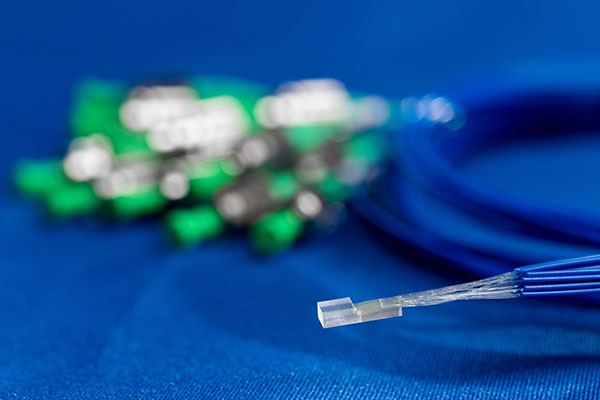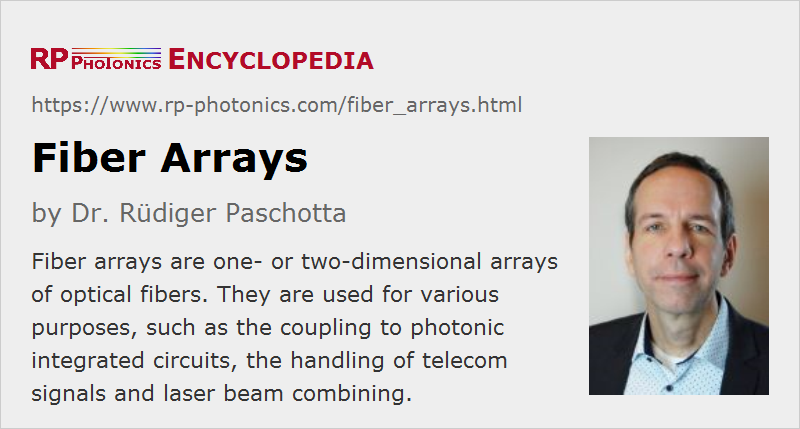Fiber Arrays
Definition: a one- or two-dimensional array of optical fibers
Alternative terms: fiber-optic arrays, fiber array units
German: Faserarrays
Category:  fiber optics and waveguides
fiber optics and waveguides
Author: Dr. Rüdiger Paschotta
Cite the article using its DOI: https://doi.org/10.61835/qso
Get citation code: Endnote (RIS) BibTex plain textHTML
Fiber arrays (or fiber-optic arrays or fiber array units) are one- or two-dimensional arrays of optical fibers. Often, such an array is formed only for the very end of a bundle of fibers, rather than over the whole fiber length. The purpose of such an array is typically either coupling light from some source array to the fibers, or from the fibers to some other component, such as to an array of planar waveguides on a photonic integrated circuit. Various other applications are explained below.

A linear fiber array is often formed by placing the individual fibers into V-grooves made on some solid surface (see Figure 1). Positioning of fibers in a two-dimensional array may be achieved with a precise array of holes in a glass or polymer piece or a metal plate, for example. Different types of 2D matrices are possible, but a simple square lattice is most common. Nearly always, a simple and very regular structure is formed, although more complicated and less regular patterns are possible. For example, there are fiber arrays with multiple groups of fibers, i.e., with an increased spacing between some of the fibers. Really irregular structures, however, are called fiber bundles. One may also have a completely regular array at the end, used as an interface, while in other parts the fibers form an irregular bundle.
Frequently, the fiber spacing is minimized as far as possible, but in some cases fiber arrays with substantially larger spacing are used for certain applications.
Technical Details
Parameters of Fiber Arrays
The key parameters of a fiber array the following:
- number of fibers and their type (base material)
- their spacing and (for 2D) the used lattice type
- core diameter and numerical aperture, or other ways of specifying the refractive index profile, which determines the mode structure
Additional details concern:
- polarization handling; in the case of polarization-maintaining fibers, also the orientation of the fast or slow axis to the array
- end face angle for non-perpendicularly polished fiber ends
- fiber core positioning accuracy
- use of end caps, mode converters and the like
- type of package
Due to the substantial number of variable parameters, fiber arrays often need to be made as custom optics, tailored for specific applications.
Used Fibers
Fiber arrays are mostly made from silica fibers, which can be suitable for various spectral regions from the near-infrared to the ultraviolet. However, they can also be made from certain specialty fibers. Both single-mode fibers and multimode fibers are used, depending on the application. In some cases, polarization-maintaining fibers (e.g. of PANDA type) are used.
Fiber Diameter
In some cases, a fiber array is formed by arranging a number of fibers in their original size, e.g. with a standard cladding diameter of 125 μm. If fiber coatings are omitted or removed (as usual), this leads to a minimum possible core spacing of the same magnitude (assuming centered fiber cores, and that no multi-core fibers are used).
For some applications, such as the coupling to photonic integrated circuits, one requires much smaller fibers and/or a smaller core spacing. In such cases, one may either use correspondingly smaller fibers straight away or use tapered fibers, produced by stretching fibers while heating them to the glass softening temperature. Sometimes, it is necessary to apply an additional mode size converter for coupling to waveguide modes with rather small dimensions. In other cases, core-less end caps of different shapes (e.g. with rectangular or circular cross-section) are applied.
Fiber Ends; Packaging
It is often important to carefully fabricate fiber arrays such that the fiber ends are well aligned in all dimensions. Further, the input or output end often needs to be packaged such that the fiber array as a whole can be conveniently and safely handled. For example, the end of a fiber array can be a block of optical glass material with a suitable shape, possibly with features aiding the alignment, similar to a fiber connector. Particularly for 2D arrays, one may also use a metal flange around them.
One may use bare fiber ends, or alternatively apply an anti-reflection coating, which much reduces parasitic reflections and thus also the coupling losses.
Cleaving and Splicing of Fiber Arrays
For volume manufacturing, it is undesirable to cleave every involved fiber separately. Therefore, laser-based cleaving processes have been developed which can be applied to whole arrays [5].
The fiber ends are usually cleaved perpendicularly, but in some cases they need to be polished at some angle against the fiber axis. Typically, one will not polish the fiber separately, but rather polish them all together after rigidly embedding them in some glass structure.
It is also possible to apply fusion splicing not only to single fibers, but to whole fiber arrays [1]. Such processes have been developed, for example using CO2 lasers for softening the fiber ends. The resulting splice losses can be quite low, at least for multimode fibers.
Coupling to a Lens Array
Particularly when the output of the fibers is sent into free space, it is often collimated with a lens array (or microlens array). Obviously, the fiber spacing then needs to be precisely matching the lens spacing, and proper alignment is crucial, since it has a strong impact on the resulting beam direction and the degree of collimation.
Applications of Fiber Arrays
Fiber arrays have rather diverse applications. Some typical examples are given in the following sections.
Coupling to Photonic Integrated Circuits
Photonic integrated circuits and similar devices in optoelectronics need to be interfaced with the outside world – mostly with fiber optics. Frequently, there is well more than a single input and output; multiple signals are guided in multiple waveguides on the circuit, and those getting to the edge of the chip need to be coupled to optical fibers. That naturally leads to the use of fiber arrays. In that case, special precautions must be taken to allow for efficient coupling between the chip waveguides and the fibers, where the former typically have far smaller mode diameters (e.g. <1 μm) than the latter (typically several microns). Typically, one will require specialized mode size converters.
Due to the small dimensions, highly accurate positioning of the fiber cores relative to the waveguides is required. That may be achieved only with active alignment, i.e., with measuring the transmission during the alignment process, often with automatic control.
Data/Telecom Applications
Frequently, one needs to split one data signal in order to distribute it to many outputs. A typical example is cable-TV, where the same set of TV programs is broadcast to multiple parties. The signal splitting (often after a fiber amplifier) is often done with a planar waveguide circuit, the outputs of which need to be coupled to fibers. A fiber array is then a natural solution for coupling the fibers to the splitter.
Similar aspects are also encountered in the context of fiber-optic switches for network routing, and in wavelength division multiplexing, where each fiber of a linear array may be associated with a different center wavelength.
In optical fiber communications, data can be sent through a single fiber at enormous bit rates, and potentially in both directions at the same time. Nevertheless, it is sometimes necessary to use multiple fibers. It is then desirable to simplify connections by using interfaces (fiber connectors) based on fiber arrays. While establishing a connection for all relevant fibers in one connecting process, one also ensures that no fibers are unintentionally exchanged.
Another application in the telecom area is the flexible routing of data signals using 1D or 2D fiber arrays in conjunction with microlens arrays and movable mirror arrays fabricated with MEMS technology. Such compact devices can be realized for use as flexible and fast optical cross connect switches.
Such technologies are not only relevant for telecom providers, but also in fields like factory automation, infrastructure monitoring, fiber-optic sensing and many others.
Astronomical Telescopes
In astronomical telescopes, one sometimes uses optical fibers to transport light from the telescope to other devices for further analysis, e.g. for high-resolution spectral analysis. Here, fiber arrays allow one to apply such techniques to multiple viewing directions at the same time.
Coupling to Laser Diode Arrays or VCSEL Arrays
Laser diode arrays, also called diode bars, contain a regular array of laser emitters. It is possible to couple such a device to a fiber array such that the radiation from each image that gets into one fiber [6]. Similar techniques can be applied to VCSEL arrays [7].
Beam Combining
Linear fiber arrays are particularly suitable for spectral beam combining. For example, one may realize one fiber laser with each fiber of an array, and combine their beams with a diffraction grating, as shown in Figure 2.

The emitter array on the left side contains one fiber for each wavelength slot. All wavelength components are fully superimposed in the output.
Coherent beam combining is also possible with a 2D fiber array in conjunction with a suitable lens array for collimation of the light [8, 9]. Here, each fiber is fed with the single-frequency and phase-stabilized output of a fiber amplifier. Very accurate positioning of all the components is vital for obtaining a high beam quality of the output.
Laser Material Processing
Various techniques of laser material processing may be performed with much increased processing speed by using a kind of parallelization, where multiple spots on the sample are irradiated at the same time, each with radiation from one fiber in an array. For arrays with limited size, the whole radiation can be treated with a single optics set. Such techniques can be realized with 1D or 2D arrays.
More to Learn
Encyclopedia articles:
Suppliers
The RP Photonics Buyer's Guide contains 27 suppliers for fiber arrays. Among them:


PhiX
PHIX Photonics Assembly offers a broad range of V-groove fiber arrays for photonic integrated circuit (PIC) connections which are used in telecommunication networks, medical equipment, space and military applications, as well as test and measurement equipment. With our extensive experience in connecting fiber arrays to PICs for various platforms like Silicon Nitride, Silicon Photonics, and Indium Phosphide, we are your partner in the selection and supply of high-quality V-groove fiber arrays.


Workshop of Photonics
WOP offers fabrication services for optical fiber alignment arrays (1D, 2D micro-hole arrays). Laser micromachining, together with SLE which we use for fiber alignment structures production, offers definite advantages in terms of precision, consistency, speed, material versatility, and cost-effectiveness.
Using our laser micromachining method, critical features such as tight tolerances, tight positional accuracies, and hole diameter – within the tolerance of ±0.25 μm – can be achieved. This tight control of metrics ensures well-controlled alignment that might reduce insertion loss and provide good repeatability.
Moreover, this method enables forming the hole entrance as a funnel, step profile, or with a conical taper for easy fiber insertion. The channels can be straight or angled (like 8̊ ).
Bibliography
| [1] | E. Egashira and M. Kobayashi, “Optical fiber splicing with a low-power CO(2) laser”, Appl. Opt. 16 (6), 1636 (1977); https://doi.org/10.1364/AO.16.001636 |
| [2] | M. Kawazu and Y. Ogura, “Application of gradient-index fiber arrays to copying machines”, Appl. Opt. 19 (7), 1105 (1980); https://doi.org/10.1364/AO.19.001105 |
| [3] | E. J. Murphy et al., “Permanent attachment of single-mode fiber arrays to waveguides”, J. Lightwave Technol. 3 (4), 795 (1985); https://doi.org/10.1109/JLT.1985.1074268 |
| [4] | A. A. Bernussi, L. Grave de Peralta and H. Temkin, “High-precision characterization of single-mode optical fiber arrays”, J. Lightwave Technol. 21 (6), 1557 (2003); https://doi.org/10.1109/JLT.2003.812157 |
| [5] | G. Van Steenberge et al., “Laser cleaving of glass fibers and glass fiber arrays”, J. Lightwave Technol. 23 (2), 609 (2005); https://doi.org/10.1109/JLT.2004.841258 |
| [6] | G. Niu et al., “Fiber optic coupling of high power laser diode array”, Chinese Opt. Lett. 5 (S1), S148 (2007) |
| [7] | J. K. Kim et al., “Arrayed multimode fiber to VCSEL coupling for short range communications using hybrid polymer-fiber lens”, IEEE Photon. Technol. Lett. 19 (13), 951 (2007); https://doi.org/10.1109/LPT.2007.898790 |
| [8] | C. Bellanger et al., “Design of a fiber-collimated array for beam combining”, Opt. Engineering 50 (2), 025005 (2011); https://doi.org/10.1117/1.3537968 |
| [9] | I. Fsaifes et al., “Coherent beam combining of 61 femtosecond fiber amplifiers”, Opt. Express 28 (14), 20152 (2020); https://doi.org/10.1364/OE.394031 |
Questions and Comments from Users
Here you can submit questions and comments. As far as they get accepted by the author, they will appear above this paragraph together with the author’s answer. The author will decide on acceptance based on certain criteria. Essentially, the issue must be of sufficiently broad interest.
Please do not enter personal data here; we would otherwise delete it soon. (See also our privacy declaration.) If you wish to receive personal feedback or consultancy from the author, please contact him, e.g. via e-mail.
By submitting the information, you give your consent to the potential publication of your inputs on our website according to our rules. (If you later retract your consent, we will delete those inputs.) As your inputs are first reviewed by the author, they may be published with some delay.



Share this with your friends and colleagues, e.g. via social media:
These sharing buttons are implemented in a privacy-friendly way!